|
Prepositions with Pronomial Suffixes
Introduction
As you have already learned, pronomial suffixes can be attached to singular nouns
(Unit 6.7) and plural nouns (Unit 6.8). In this unit you will see that they may be attached to prepositions as well.
Prepositions are neither singular nor plural, but some prepositions take the suffixes added to singular nouns (called "Type I" endings) while others take the suffixes added to plural nouns (called "Type II" endings). The type of endings attached to a given preposition must be learned on a case-by-case basis (fortunately, in either case they are easy to recognize when you see them).
Type I Pronomial Endings
Some prepositions take the pronomial suffixes you have learned for singular nouns. Following academic convention, I will refer to these as "Type I" pronomial endings:
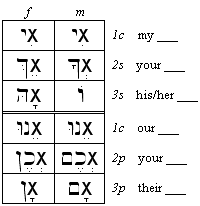
In the paradigm given above, note that the "X" refers to the last letter of the preposition.
You will need to memorize these suffixes so that when you see a preposition with one of these endings, you will understand that an objective personal pronoun is "embedded" into the meaning of the word.
Example Paradigm: Type I Preposition
Consider the inseparable preposition Lamed and note how the Type I endings are directly applied:
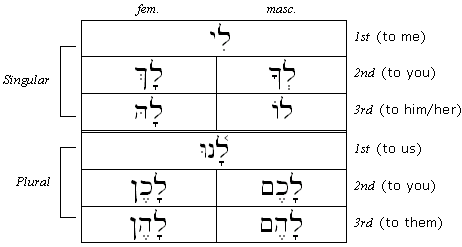
Note that the only exception to the pronomial endings you have studied for singular nouns is in the case of the 2fs where the Tsere has changed to a Qamets.
Other prepositions that take Type I endings include:


Tip: When learning the prepositions, you might want to note what type of pronomial endings it takes. For example, when creating a flashcard for the preposition 'im, you might want to indicate that it takes Type I pronomial endings.
Type II Pronomial Endings
Other prepositions take the pronomial suffixes you have learned for plural nouns. Again, following academic convention, I will refer to these as "Type II" endings:
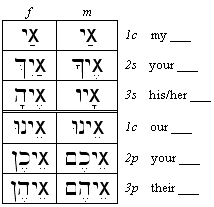
Again, in the paradigm given above, note that the "X" refers to the last letter of the preposition.
Example Paradigm: Type II Preposition
Consider the preposition 'al and note how the Type II endings are directly applied:
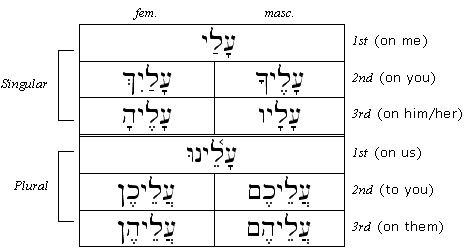
These prepositions take the same endings you have studied for plural nouns, so you should not have too much difficuly recognizing them when you see them. Other prepositions that take Type II endings include:
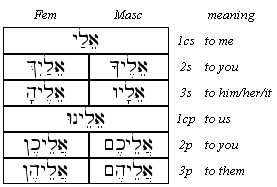

Tip: When learning the prepositions, you might want to note what type of pronomial endings it takes. For example, when creating a flashcard for the preposition achar, you might want to indicate that it takes Type II pronomial endings.
Section Exercises
- Memorize (or review) the Type I and Type II endings for prepositions.
- For each of the prepositions you already know, determine whether they take Type I or Type II endings (use your lexicon). Note this on your flashcards.
- Inflect each preposition you know according to person, gender, and number (use the tables above as a guide).
<< Return
|


